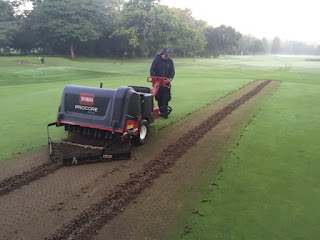This year has been another unpredictable year and particularly this winter. No hard frosts to date and unusually mild conditions which has very rarely seen temperatures drop into single figures.With these conditions comes the risk of very high disease pressure. Many other Clubs have suffered severely in these conditions, fortunantely we have managed to contain any aggressive outbreaks to a minimum.
We believe this is all due to a combination of our pro-active management which includes preventative fungicide applications, assisted by practical methods of regular aeration, greens maintenance (hollow-coring), and by increasing levels of sunlight and air movement across the fine turf areas through our woodland management. All of these methods help to compliment each other and it is essential that these practises are continuously maintained for the future sustainability of the Club. Their are many positives to be highlighted during this mild period. Although there are many unsightly marks from machinery and golfer traffic, we have managed to keep most areas completely free of leaves and the need to use temporary greens or to close the course has not yet been required.
All in all another succesful year with many improvements just adding onto those already just a thing of the past. Before these changes become just a part of LPGC's history, lets remind ourselves of some of the highlights and improvements of 2015.
New Practice Nets
The Loggery
Greens Maintenance / Hollow-Coring
Dry Rainge Practice Area
Tree & Woodland Management





















































